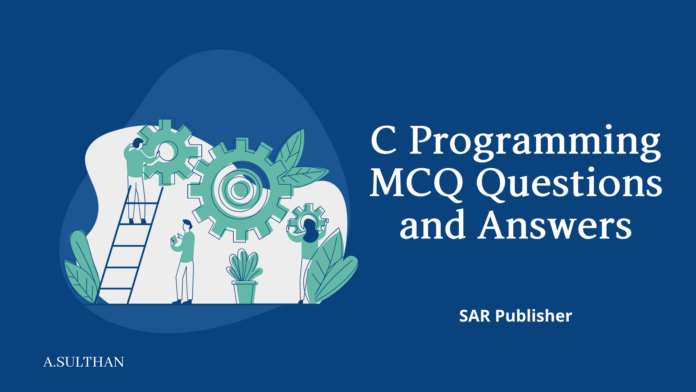C Programming MCQ Questions and Answers Part – 1
C Programming MCQ Questions and Answers Part – 2
C Programming MCQ Questions and Answers Part – 3
101. All standard C library <math.h> functions return what data type?
A. decimal.
B. float.
C. double.
D. int.
ANSWER: C
102. When a function is recursively called all automatic variables are ___________.
A. stored in stack.
B. stored in queue.
C. stored in array.
D. stored in linked list.
ANSWER: A
103. What is the output of the following code? main() { printf(%d\n,sum(5)); } int sum(int n) { if(n<1) return n; else return(n+sum(n-1));
A. 10.
B. 16.
C. 14.
D. 15.
ANSWER: D
104. Pointers are supported in________.
A. FORTRAN.
B. PASCAL.
C. C.
D. FORTRAN,C,PASCAL.
ANSWER: D
105. Pointer variable may be assigned_______.
A. an address value represented in hexadecimal.
B. an address value represented in octal.
C. the address of another variable.
D. an address value represented in binary.
ANSWER: C
106. The operators exclusively used in connection with pointers are________.
A. *
B. &
C. .
D. a and b
ANSWER: D
107. Identify the wrong declaration statement________.
A. int *p, a=10.
B. int a=10,*p=&a.
C. int *p=&a, =10.
D. options 1 and 2.
ANSWER: C
108. The operator % can be applied only to __________ .
A. float values.
B. double values.
C. character values.
D. integer values.
ANSWER: D
109. The address of operator returns________.
A. the address of its operand.
B. 1 value.
C. both options a and b.
D. r value.
ANSWER: A
110. Structural programming approach makes use of _________.
A. modules.
B. control structures.
C. user defined data types.
D. all of the above.
ANSWER: D
111. The number of arguments used in malloc ( ) is_______.
A. 0.
B. 1.
C. 2.
D. 3.
ANSWER: B
112. Loss in precision occurs for typecasting from____________.
A. float to double.
B. char to short.
C. float to int.
D. long to float.
ANSWER: C
113. The pointers can be used to achieve_____.
A. call by function.
B. call by reference.
C. call by name.
D. call by procedure.
ANSWER: B
114. Which among the following is odd one out?
A. printf.
B. fprintf.
C. putchar.
D. scanf .
ANSWER: D
115. Given int *p1,**p2,***p3,v=25;How to obtain the value of v using pointer variable?
A. *p1.
B. **p2.
C. ***p3.
D. all the above.
ANSWER: D
116. Identify the correct statement for given expression as________. Float fnum [10], *fptr = fnum
A. fnum is pointer variable.
B. fnum is a fixed address and not a variable.
C. fnum is an array variable.
D. fnum is an address that can be modified.
ANSWER: B
117. Given int a[5];how to declare array in the function definition if the function call is sort(a)______.
A. sort(int *a).
B. sort(int a[5]).
C. sort(int *a),sort(int a[5]).
D. sort(int a).
ANSWER: C
118. The value of EOF is_____.
A. -1
B. 0.
C. 1.
D. 10.
ANSWER: A
119. The declaration float *a[5];is_______.
A. an ordinary array.
B. a pointer to an array.
C. an array of pointers.
D. pointer to an array.
ANSWER: C
120. The arguments argc in main( ) counts_______.
A. the number of command line strings including the execution command.
B. the number of command line strings excluding the execution command.
C. the number of lines in a program.
D. the number of characters in a program.
ANSWER: A
121. In the declaration double (*pf)( ); as _________.
A. pf is a pointer to a function.
B. pf is a function returning pointer.
C. pf is a pointer to array.
D. pf is an array of pointers.
ANSWER: A
122. The operation that can be performed on pointers are______.
A. addition and subtraction of a pointer and an integer.
B. assignment of pointer using pointer expression.
C. assignment of the value 0 to a pointer.
D. all the above.
ANSWER: D
123. When applied to a variable, what does the unary & operator yield?
A. the variable value.
B. the variable address.
C. the variable format.
D. the variable right value.
ANSWER: B
124. Which of the following is the most accurate statement about runtime memory?
A. memory is allocated by using malloc ( ).
B. memory is freed by a garbage collector.
C. allocated memory can be freed by calling free ( ).
D. memory is allocated by using malloc ( ), allocated memory can be freed by calling free().
ANSWER: D
125. The storage class allowed for parameters is _________.
A. auto storage class.
B. static storage class.
C. extern storage class.
D. register storage class.
ANSWER: C
126. The function strcpy(s1,s2) in string.h __________.
A. copies s1 to s2.
B. copies s2 to s1.
C. appends s1 to end of s2.
D. appends s2 to end of s1.
ANSWER: B
127. Recursive call results when ________.
A. a function calls itself.
B. a function1 calls another function, which in turn calls the function1
C. both 1 & 2.
D. a function calls another function.
ANSWER: C
128. Which statement correctly defines a character string with a length of 4 plus 1 for the terminating NUL?
A. char string[ ];.
B. char* string[ ];.
C. char * string[5];.
D. char string[5];.
ANSWER: D
129. Which are valid?
A. Pointers can be added.
B. Pointers can be subtracted.
C. integers can be added to pointers
D. Both a and b are correct.
ANSWER: A
130. The pointers can be used to achieve _________.
A. call by function.
B. call by reference.
C. call by name.
D. call by procedure.
ANSWER: B
131. Structure is a_____.
A. scalar data type.
B. derived data type.
C. both a and b.
D. primitive data type.
ANSWER: B
132. Structure is a data type in which______.
A. each element must have the same data type.
B. each element must have pointer type only.
C. each element may have different data type.
D. no element is defined.
ANSWER: C
133. C provides a facility for user-defined data type using______.
A. pointer.
B. function.
C. structure.
D. array.
ANSWER: B
134. Structure declaration _______.
A. describes the prototype.
B. creates structure variable.
C. defines the structure-function.
D. not necessary.
ANSWER: A
135. A structure_________.
A. can be read as a single entity.
B. cannot be read as a single entity.
C. can be displayed as a single entity.
D. has a member variable that cannot be individually read
ANSWER: B
136. A structure have________.
A. pointers as its members.
B. scalar data type as its members.
C. structure as its member.
D. all the above.
ANSWER: C
137. In a structure definition________.
A. initialization of structure members are possible.
B. initialization of array of structures are possible.
C. both a and b.
D. initialization of array of structures are not possible.
ANSWER: C
138. The function putchar() uses ___________ .
A. no argument.
B. one argument that is a character variable.
C. one argument that is the ASCII value of a character.
D. one argument, that is a string.
ANSWER: A
139. The version C is also referred to as __________.
A. C10.
B. C70.
C. C89.
D. C90.
ANSWER: C
140. C program was developed at __________ laboratories.
A. USA.
B. Sun.
C. Bell.
D. C++.
ANSWER: C
141. C program can be viewed as a group of building blocks called __________.
A. groups.
B. functions.
C. statements.
D. structures.
ANSWER: B
142. All statements in the declaration and executable parts end with a __________.
A. comma.
B. bracket.
C. parenthesis
D. semicolon.
ANSWER: D
143. The smallest individual units in a C program are called __________.
A. characters.
B. symbols.
C. tokens.
D. identifiers.
ANSWER: C
144. All keywords must be written in ___________.
A. upper case.
B. lower case.
C. within codes.
D. separately.
ANSWER: B
145. ANSI C supports __________ classes of data types
A. one.
B. two.
C. three.
D. four.
ANSWER: C
146. A double data type has __________ bytes.
A. two.
B. four.
C. six.
D. eight.
ANSWER: D
147. Declaration of __________ must be done before they are used in the program.
A. variables.
B. constants.
C. loops.
D. branches.
ANSWER: A
148. The enumerated data type is a __________ data type.
A. derived data type.
B. user-defined data type.
C. primary data type.
D. fundamental data type.
ANSWER: B
149. The variable which has been declared before the main is called __________ variable.
A. local.
B. global.
C. static.
D. auto.
ANSWER: B
150. Expressions are evaluated using a __________ operator
A. conditional operators.
B. assignment operators.
C. bitwise operators.
D. special operators.
ANSWER: B


